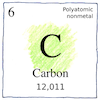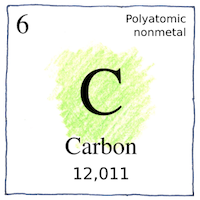China, India, Egypt, Sumeria
elements

|
Carbon
Organic chemistry is defined as the chemistry of carbon compounds. All known life-forms plant and animal are made with carbon.
Atomic number 6
Neolithic people carved ornaments from coal in the Shenyang area of China. People in India found diamonds in alluvial deposits and related them to Indra’s thunderbolt. The civilizations in Egypt and Sumeria used coal and charcoal.
Forms of carbon
Soot, charcoal, coal, coke, atomic and diatomic carbon, carbine-derived carbon, diamond and vitreous carbon, coal tar, carbon black, carbon dioxide, water gas, carborundum or silicon carbide, graphite, graphene, buckminsterfullerene, carbon nanotube, nanobud, and nanofoam, and carbon fibre, viruses, archaea, bacteria, and eukaryotes which include protozoa, plants, algae, fungi, slime molds, and animals such as us, all have something in common. Enough said?



Carbon is among the earliest elements recognized and among the latest to have newly discovered allotropes.
See also in The book of science:
Readings in wikipedia:
Other readings: